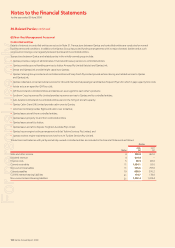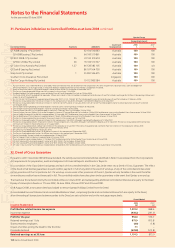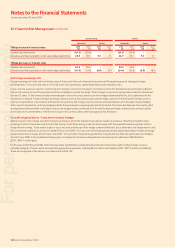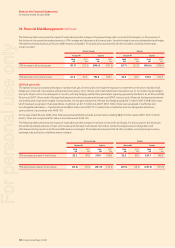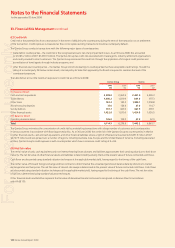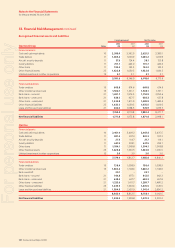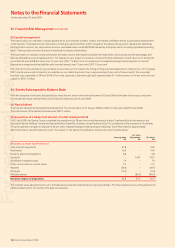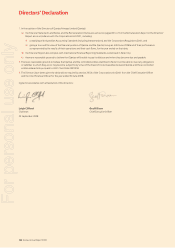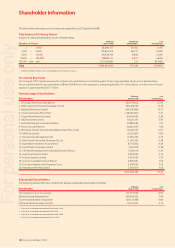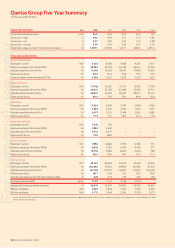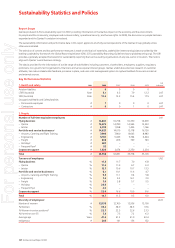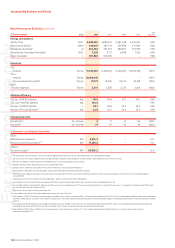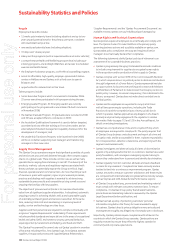Qantas 2008 Annual Report Download - page 142
Download and view the complete annual report
Please find page 142 of the 2008 Qantas annual report below. You can navigate through the pages in the report by either clicking on the pages listed below, or by using the keyword search tool below to find specific information within the annual report.
140 Qantas Annual Report 2008
Notes to the Financial Statements
for the year ended 30 June 2008
(C) Credit risk
Credit risk is the potential loss from a transaction in the event of default by the counterparty during the term of the transaction or on settlement
of the transaction. Credit exposure is measured as the cost to replace existing transactions should a counterparty default.
The Qantas Group conducts transactions with the following major types of counterparties:
trade debtor counterparties – the credit risk is the recognised amount, net of any impairment losses. As at 30 June 2008, this amounted
to $1,085.2 million (2007: $1,039.9 million). The Qantas Group has credit risk associated with travel agents, industry settlement organisations
and credit provided to direct customers. The Qantas Group minimises this credit risk through the application of stringent credit policies and
accreditation of travel agents through industry programs; and
other fi nancial asset counterparties – the Qantas Group restricts its dealings to counterparties that have acceptable credit ratings. Should the
rating of a counterparty fall below certain levels, internal policy dictates that approval by the Board is required to maintain the level of the
counterparty exposure.
The table below set out the maximum exposure to credit risk as at 30 June 2008:
Qantas Group Qantas
2008
$M
2007
$M
2008
$M
2007
$M
On Balance Sheet
Cash and cash equivalents 2,599.0 3,362.9 2,461.0 3,409.3
Trade debtors 1,085.2 1,039.9 841.3 937.3
Other loans 142.2 142.2 1,994.1 1,018.8
Aircraft security deposits 37.6 124.4 27.3 114.7
Sundry debtors 701.7 443.0 627.5 299.1
Other fi nancial assets 1,422.8 1,030.5 1,424.8 1,030.5
Off Balance Sheet
Operating leases as lessor 126.0 134.0 67.2 52.0
Total 6,114.5 6,276.9 7,443. 2 6,861.7
The Qantas Group minimises the concentration of credit risk by undertaking transactions with a large number of customers and counterparties
in various countries in accordance with Board approved policy. As at 30 June 2008, the credit risk of the Qantas Group to counterparties in relation
to other fi nancial assets, cash and cash equivalents, and other fi nancial liabilities where a right of offset exist amounted to $3,831.9 million (2007:
$4,727.5 million) and was spread over a number of regions, including Australia, Asia, Europe and the United States of America. Excluding associated
entities, Qantas Group’s credit exposure is with counterparties which have a minimum credit rating of A- / A3.
(D) Net fair value
The net fair value of cash, cash equivalents and non-interest-bearing fi nancial assets and liabilities approximates their carrying value due to their short
maturity. The net fair value of other fi nancial assets and liabilities is determined by valuing them at the present value of future contracted cash fl ows.
Cash fl ows are discounted using standard valuation techniques at the applicable market yield, having regard to the timing of the cash fl ows.
The net fair value of forward foreign exchange and fuel contracts is determined as the unrealised gain/loss at balance date by reference to market
exchange rates and fuel prices. The net fair value of interest rate swaps is determined as the present value of future contracted cash fl ows. Cash fl ows
are discounted using standard valuation techniques at the applicable market yield, having regard to the timing of the cash fl ows. The net fair value
of options is determined using standard valuation techniques.
Other fi nancial assets and liabilities represent the fair value of derivative fi nancial instruments recognised on Balance Sheet in accordance
with AASB 139.
•
•
33. Financial Risk Management continued
For personal use only


